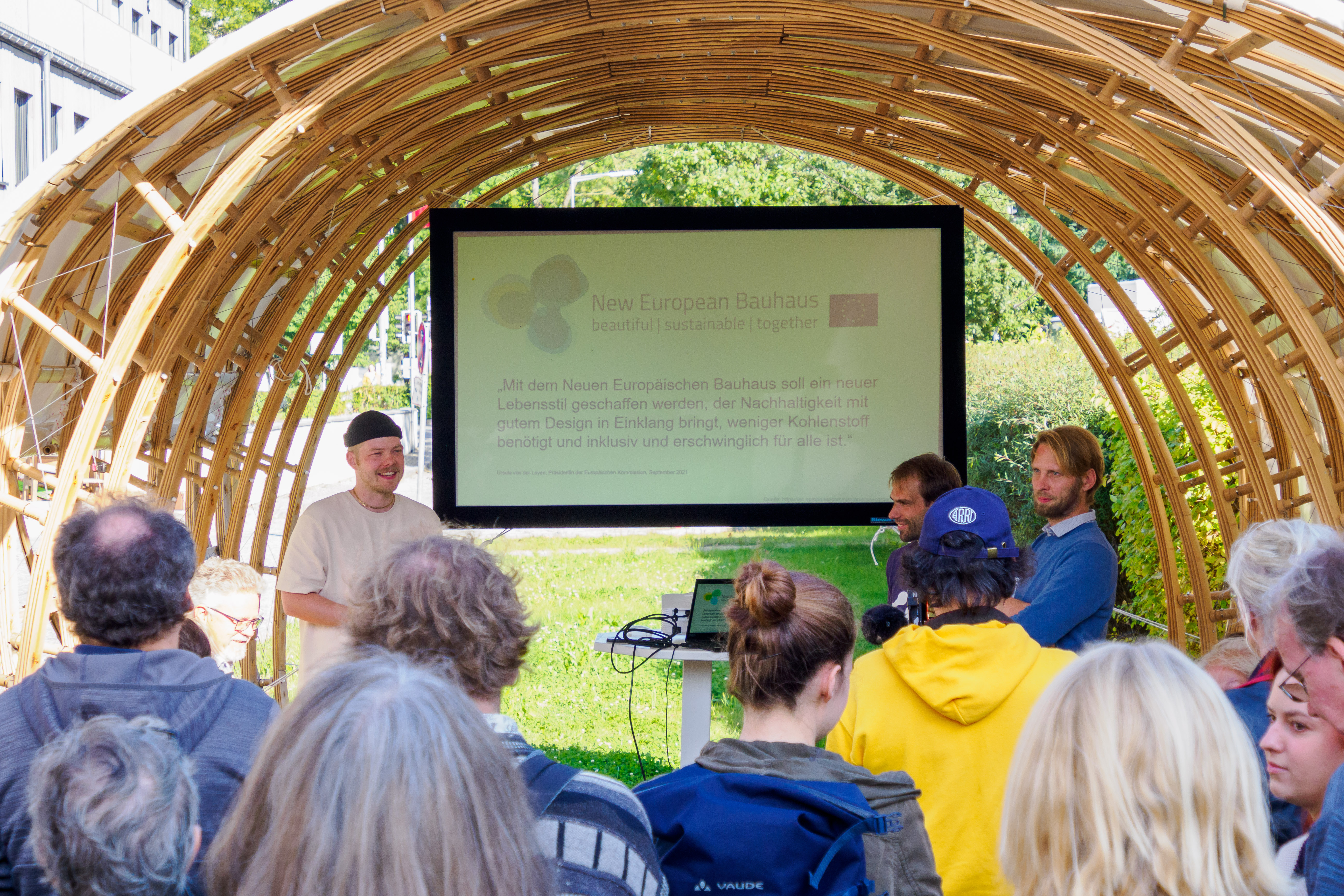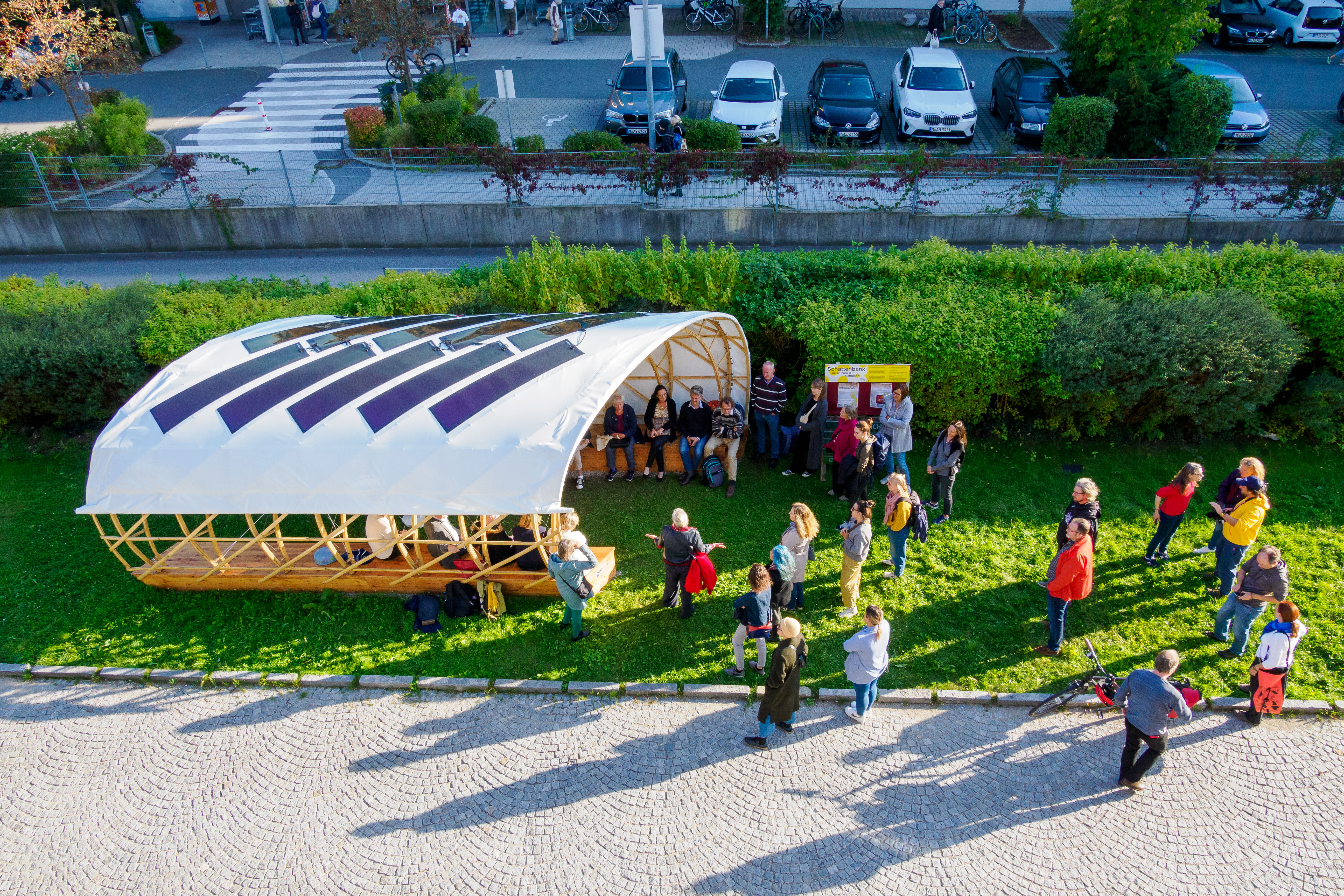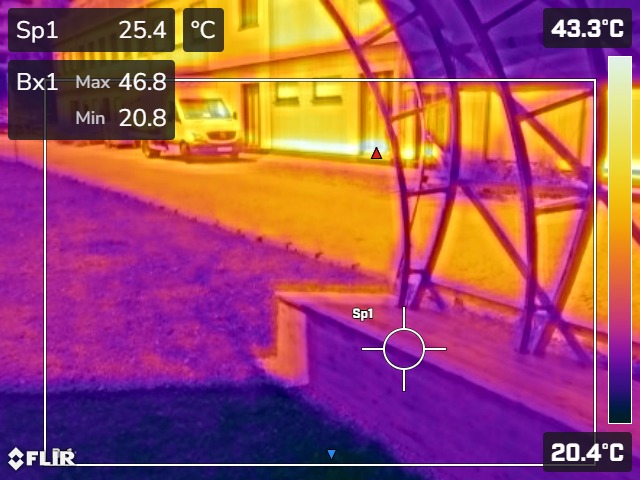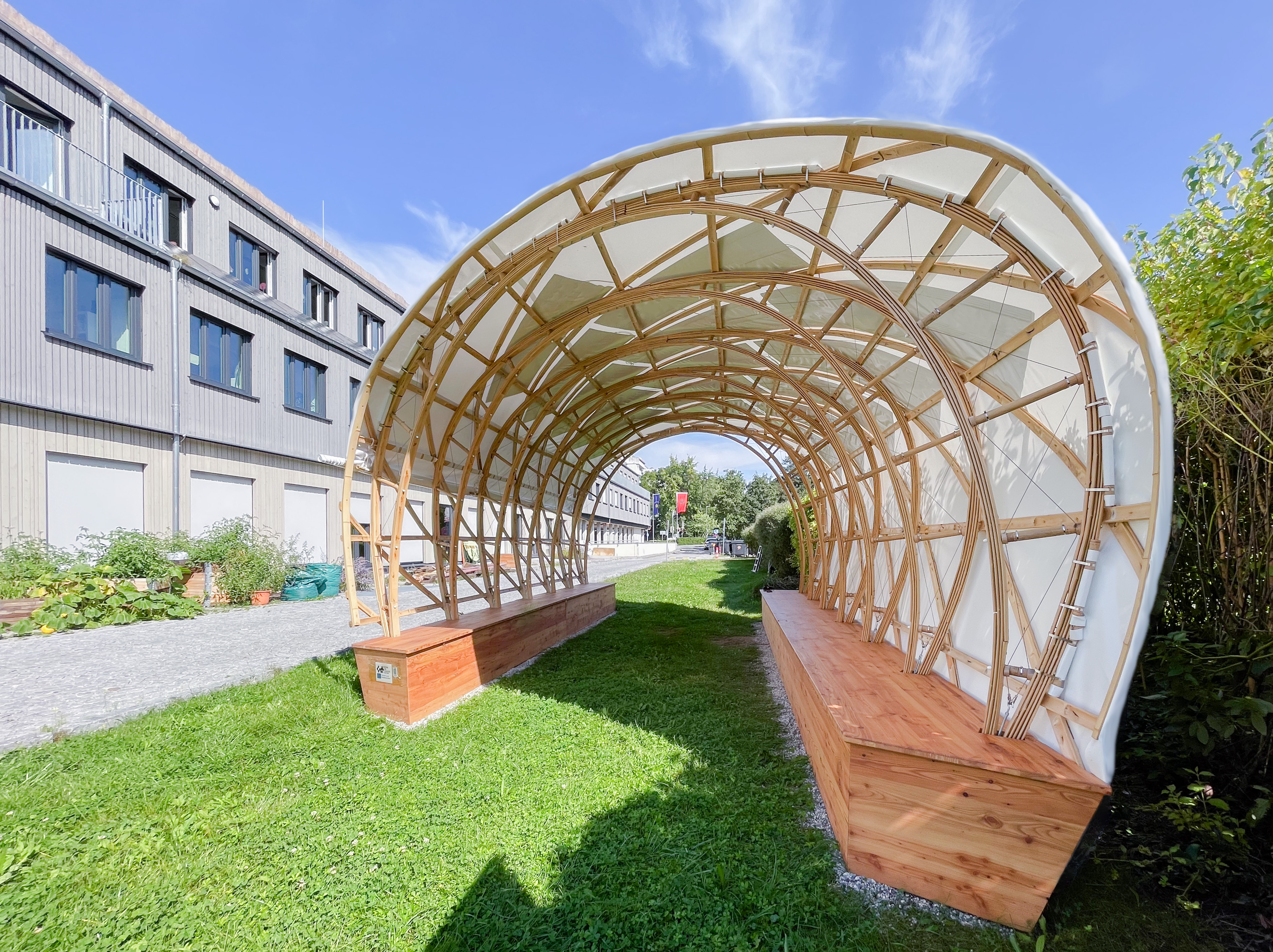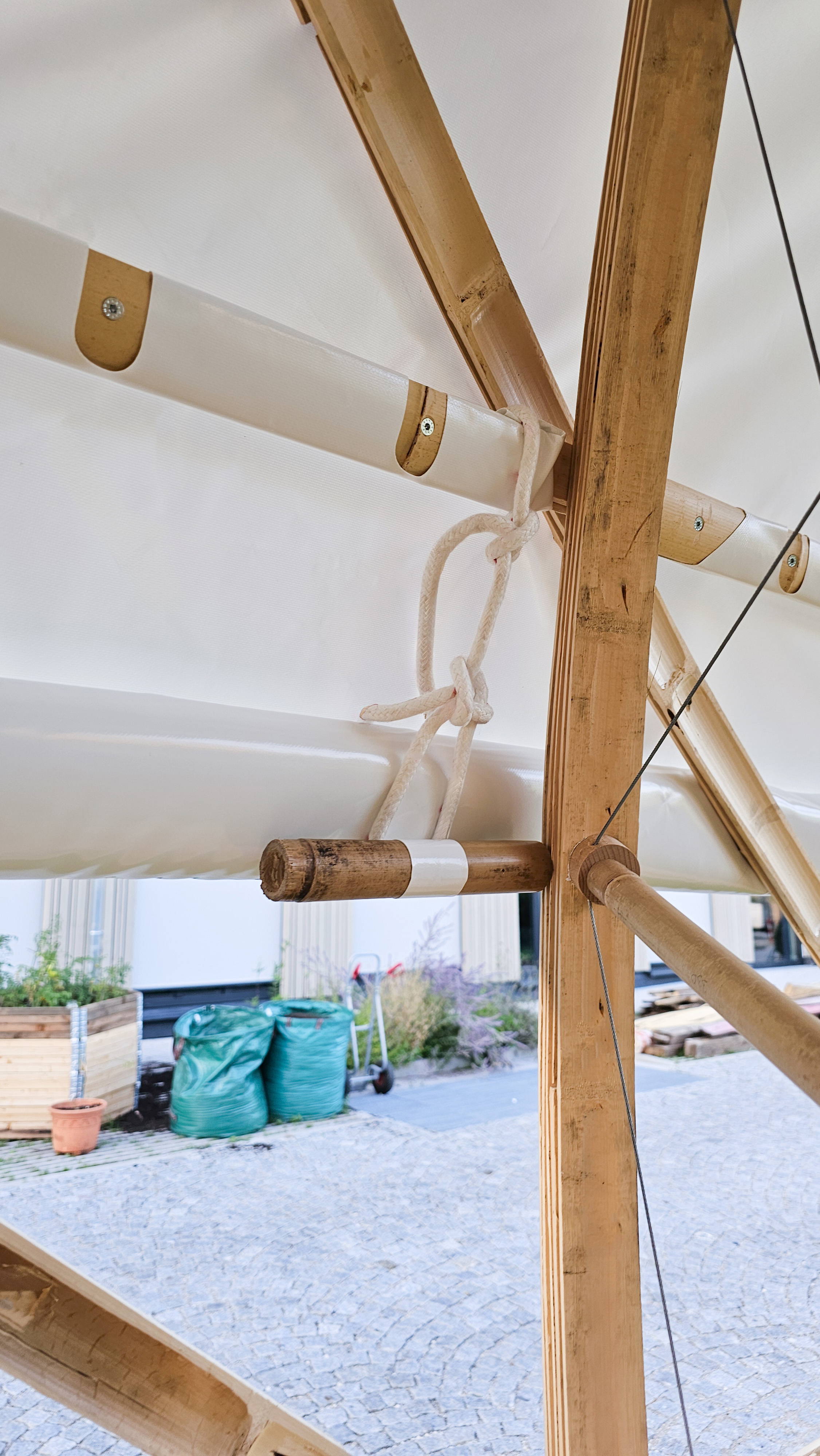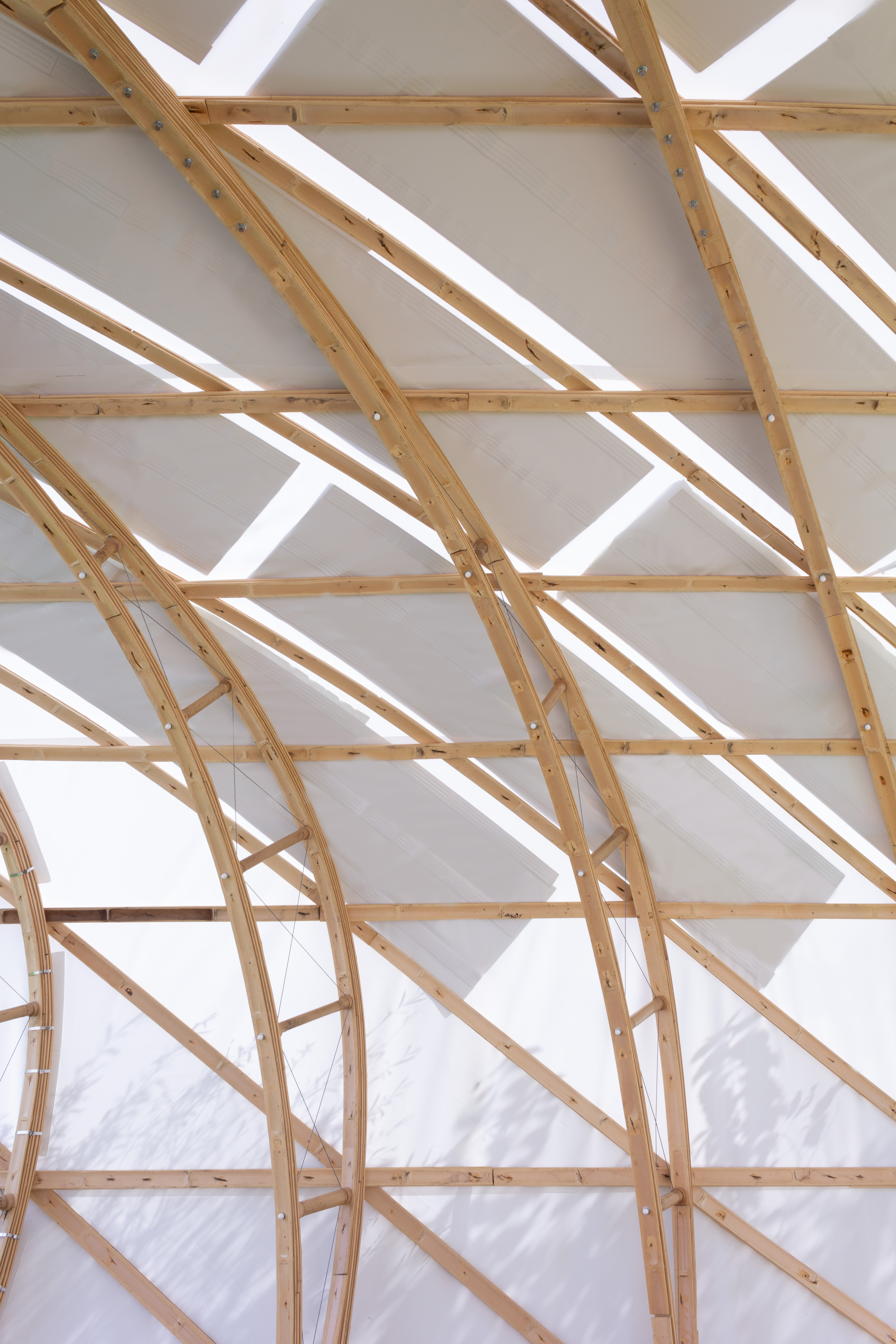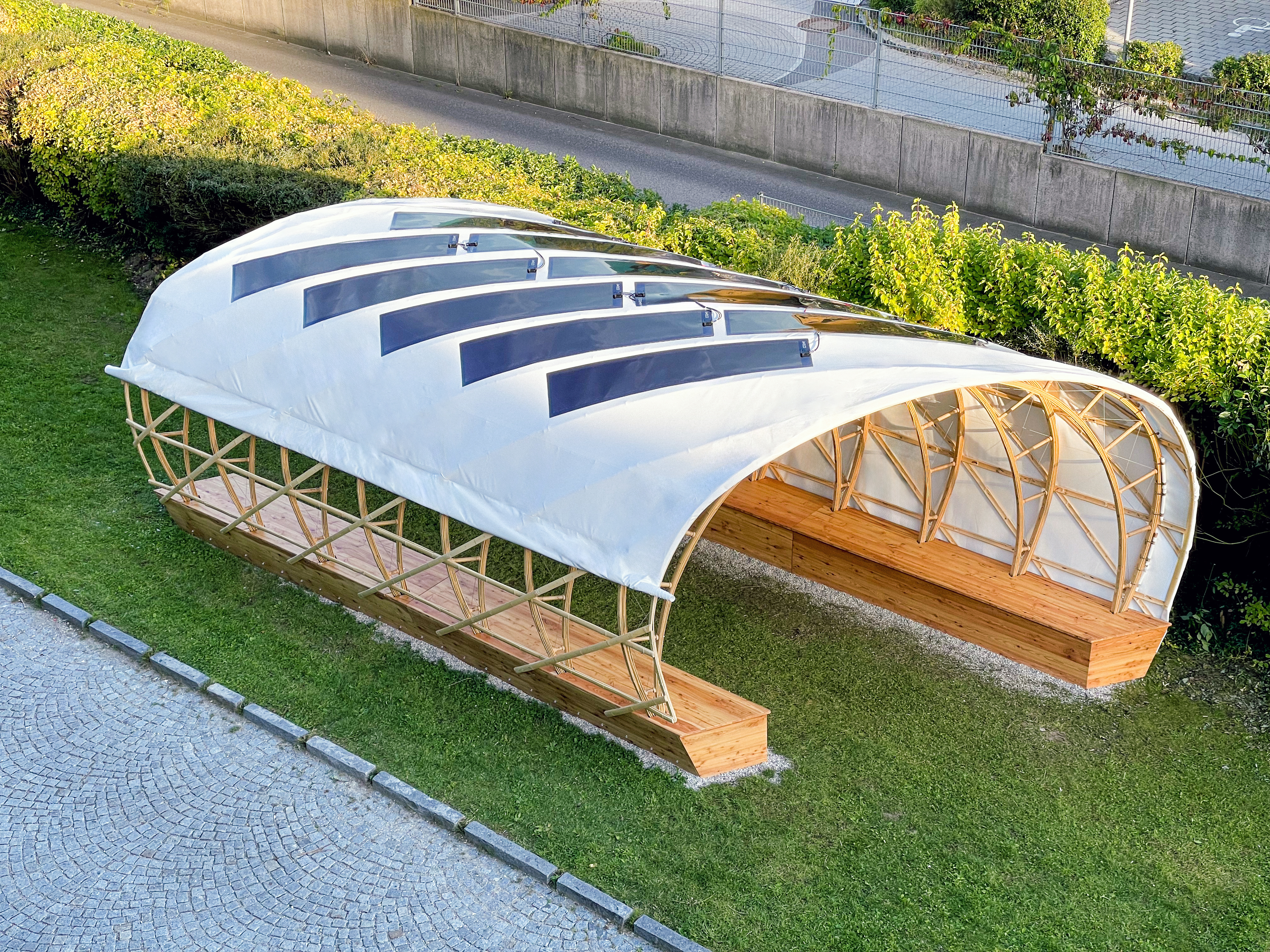Prioritising the places and people that need it the most
Public Power
Public Power - Demonstration of PV Shading Structure
Vast areas of the public realm are becoming a threat to our thermal health as the urban fabric we designed decades ago, cannot mitigate the increasing heat exposure due to climate change. Posing a health risk to vulnerable groups (young children, senior citizens, and people with pre-existing conditions), Public Power implemented socially, ecologically, and sustainably valuable shading to reduce the temperature in urban spaces to restore the quality of life and prevent social exclusion.
Germany
Local
Munich, Germany
Mainly urban
It refers to a physical transformation of the built environment (hard investment)
Yes
2024-09-13
Yes
Horizon2020 / Horizon Europe
No
No
As an individual partnership with other persons/organisation(s)
The growing heat stress caused by climate change is turning large parts of urban areas into a threat to our health. Urban overheating is a global phenomenon affecting pedestrians in cities worldwide, urgently requiring strategies to adapt to changing climatic conditions. Vulnerable groups, in particular, are at risk from thermal stress, making public spaces difficult for them to access. Our NEB Action aims to reduce temperatures in urban areas through shading measures, preventing social exclusion, and restoring the quality of public spaces. In Neuperlach, we examine heat islands in public spaces and identify areas where shading measures make sense regarding their social usability, ecological integration, and economic value. Through participatory formats, we are working with the community to develop demonstrators that showcase how climate-conscious design can lead to social, ecological, and economic enhancement, foster identity, and create an inclusive, livable, beautiful, and sustainable city. The key objective was to examine the neighborhood for heat islands in public spaces and identify areas that make sense for shading measures in terms of their social usability, ecological integration, and sustainable value. This includes not only shading but also the secondary potential analysis of combination solutions with photovoltaic systems to expand renewable energy production and infrastructure beyond the adaptation of the building stock to the public realm as a mediator for the energy transformation. By transforming public spaces to be accessible to all, Public Power engages in the empowerment of vulnerable groups like children, the elderly, and people with pre-conditions or little heat tolerance.
Heat Voulnerability
Urban Heat Island Effect
Photovoltaic Shading
Thermal Accessibility
Climate-Responsive Design
Munich aims to be climate-neutral by 2035, with its city administration targeting 2030 for its own operations. This aligns with international climate commitments, including the Paris Agreement and Germany’s updated climate protection law, which mandates a 65% emission reduction by 2030 and full climate neutrality by 2045. To meet these ambitious goals, Munich plans to expand climate protection efforts without significantly restricting daily life. A key focus is renewable electricity generation, particularly through photovoltaic (PV) expansion. Currently, private households account for 11% of Munich's emissions, while businesses and services contribute about 50%, largely due to electricity consumption. This demand is expected to rise with electrification in heating, industrial processes, and mobility. However, PV expansion faces challenges in dense cities. Flat roofs, often used for recreation or green spaces, are not always available for solar panels. Historical buildings (14% of PV potential) and high real estate prices further hinder progress. Additionally, most suitable rooftops are privately owned, requiring owner incentives. Unlike rooftops, street spaces are city-owned, making PV-covered roads a scalable alternative. Munich’s streets and rail areas cover 5,239 hectares (17% of the city), more than the 4,391 hectares of total building rooftops (14%). Utilizing roadways for PV could boost renewable energy production and help cool urban heat hotspots. Public Power offers an energy production site by integrating PV panels and a net-positive carbon sink over time while furthermore using the design principles of disassembly to close the loop and relying solely on carbon-low materials like bamboo and wood.
Public Power enhances a sense of belonging and bridges the school's identity with the surrounding neighborhood by activating unused public space and people. While the overall schoolyard garden enables creation and integrates social values, Public Power only acts as an umbrella for creating that necessary space. The system is scalable to respond to different locations and create the best possible shading situation and maximum PV gains. A simple construction was at the heart of the design process. It makes it possible to produce and assemble the structure with simple means, even without expensive, complicated or heavy tools. This is intended to create a higher level of identification through participation. The membrane is supported by a lightweight structure of bamboo trussed arches. The static height follows the expected loads, thus saving material. The arches consist of several layers of bamboo slats and culms and are pre-stressed by thin ropes. Bamboo, which belongs to the grass family, grows very quickly, between 30 - 80 cm a day under good conditions. As a fast-growing natural product, bamboo is very sustainable and stores even more CO2 then hardwood. On hot summer days, the north-facing membrane can be rolled up manually to optimize ventilation and the cooling effect. At the same time, this provides views to the school and a more open, lighter structure. On uncomfortable days, the closed membrane improves weather protection. The two benches serve as a foundation and ballast for the prototype. This means that the pavilion can be erected without needing to be anchored to the ground. This is particularly necessary for construction above underground car parks and on bridges but also ensures optimum dismantling and separation. This applies to the entire structure: the PV elements on the membrane can also be removed so that they can be reused.
As mammals, humans are homeothermic, meaning we must maintain our core body temperature at around 37°C. Even a deviation of just a few degrees can pose serious health risks or even be life-threatening. We regulate our energy use through physical processes and behavioral changes. This evolutionary adaptation allows us to survive and function in environments that differ significantly from our ideal body temperature. Our bodies constantly exchange heat with the surrounding environment, influenced by factors such as the weather conditions, the clothes we wear, and how active we are (whether exercising or relaxing in a hammock). The interaction of these processes determines whether the body gains or loses heat and remains in balance. Generally, the higher the ambient temperature, the harder it is for the body to release heat. However, there are individual and physiological factors that are hard to quantify and are often overlooked when designing public spaces. Especially vulnerable groups like children, the elderly, and people with pre-conditions or little heat tolerance, are often excluded from these public places and will be more so in a warming future climate. The best protection against heat is to seek shade. The project is located at a public schoolyard with paved street surfaces that heat up to 30–40°C during the day, while the unpaved ground under the new shading structure remains at only 20°C at the same time, making it about 10–20°C cooler. Especially on days with direct sunlight, our shading has proven particularly effective in protecting against extreme heat. Now, the school even teaches classes outdoors in the shade while using solar-produced electricity to power projectors and computers.
Public Power promotes a new way of thinking about the public realm by empowering all people to activate public spaces and by densifying the walkable area of a city, which creates new social behaviors. Furthermore, it shifts the conventional energy production approach from the private to the public realm, laying the foundation for a cheaper and quicker transformation towards net-zero energy. Before implementing these measures, we tested them in various demonstrators throughout the neighborhood to get feedback from local citizens. Several events were set up as interactive walks through Neuperlach with pop-up presentations at five locations. The overall tour lasted around 4 hours, with people dropping out and joining in along the way (with no more than 25 people in total). The walking tour was accompanied by subjective evaluation through three participant questionnaires. The first questionnaire was used as a simplified vote response towards the demonstrators as part of an overall information sheet that primarily communicated the project context and goal. The second addressed more specific feedback towards the single designs as well as the effectiveness of shading and the perceived relevance of the project. The third was in the form of two large areal images on which the participants located their respective answers with stickers: Where in Neuperlach do you feel heat the most? and: Where would you like to see this design implemented? The evaluation of the subjective feedback showed the importance of communication and interaction with the public. While all projects show a high degree of effective cooling when analyzing the difference in surface temperatures due to the provided shade, the subjective success of the demonstrators and presentations varied substantially, with people voicing positive and reassuring feedback to valid concerns and displeasures. This interaction with the public was a milestone in the design and location of the final shading structure.
While this project was implemented, we understand now that the limited implementation of similar projects can be attributed to several factors. A key challenge is the lack of existing models to follow; it is always easier to implement a concept when proven examples already exist. Additionally, insufficient awareness remains about the importance of addressing shading and renewable energy integration in urban spaces. Building in public spaces presents unique difficulties compared to private settings. Public projects typically involve a greater number of stakeholders, including decision-makers and various municipal authorities, which complicates the process. Stricter regulations and higher requirements, such as ensuring resistance to vandalism, further add to the complexity. Ambiguities surrounding ownership and decision-making authority – questions like "Who owns what?" or "Who has the final say?" – also create significant barriers. Lastly, public space projects often face longer implementation timelines, making rapid deployment difficult. Ultimately, it all comes down to the perception of higher costs. Increasing awareness of the importance of shading and renewable energy integration in public spaces was essential to address these challenges. We approached Public Power together with decision-makers on a municipality and local level as an investment, recognizing the long-term social, environmental, and economic benefits it offered. Still, cities must also take greater responsibility in driving these initiatives, providing leadership and resources to ensure their successful implementation. In this context, municipal contributions – such as funding, expertise, or streamlined processes – could play a crucial role in overcoming barriers and accelerating the realization of these measures. Stakeholders such as the neighborhood and school were eager to participate in all levels of engagement, including workshops, climate walks, and hands-on assembly of the final prototype.
Public Power combines several disciplines like architecture, engineering, urban planning, climate design, human physiology, and building technology. Beyond that, the project created formats that involved academic, non-academic, and cooperation partners and stakeholders. From the early stages of conceptualization, the project embraced a collaborative approach. Architects and urban planners played a central role in designing the shading structures, focusing on scalability, adaptability, and aesthetic integration into the urban fabric. Climate scientists contributed valuable insights regarding heat islands, microclimatic conditions, and the potential benefits of shading structures in reducing thermal stress. Engineers ensured that the lightweight bamboo structures were both durable and efficient, considering wind loads, material strength, and ease of construction. Human physiology experts provided critical input regarding heat sensitivity among vulnerable populations, ensuring that the design adequately addressed accessibility. Beyond these technical disciplines, we actively engaged academic and non-academic stakeholders, including local municipalities, schools, and neighborhood groups, to ensure that the project aligned with real-world needs. A crucial part of the collaboration was the participatory approach, where residents and students were directly involved in co-designing the structures and providing feedback on their usability and effectiveness. This iterative process refined the final design, ensuring it was not only functional but also embraced by the community. By merging data-driven climate research with participatory urban design Public Power serves as a replicable model for cities worldwide in a way that fosters community engagement and long-term sustainability. Our success highlights the importance of cross-disciplinary collaboration in tackling complex urban challenges, proving that diverse expertise leads to more innovative and effective solutions.
Many shading projects already exist, especially in cities of hotter climate zones, but their impact on reducing urban heat stress becomes significant only when implemented at a certain scale. However, scaling up such projects quickly becomes expensive, and cities often lack the necessary funding to support them. Integrating photovoltaic (PV) systems into shading structures offers a practical solution. By generating renewable energy in public spaces, these installations can help offset costs, making large-scale shading projects more financially viable while simultaneously contributing to sustainable energy transition at a municipal level. Furthermore, Public Power ensured stakeholder participation (i.e., Campus di Monaco) by developing and designing collaboratively and dynamically from the beginning. All project stages were communicated within different inclusive formats to the public and neighborhood, and decisions were consolidated by public feedback throughout all stages. Public Power doesn’t empower and sustain grass-roots initiatives beyond project implementation, as the shading structure itself is owned and operated by a private stakeholder (Campus di Monaco). So while Public Power sets precedence on transforming urban public landscapes worldwide, it acts locally and interacts only within a tight network within the neighborhood, for a fast and easy implementation.
In general, the action Public Power aims to develop demonstrators in data-based formats that show how climate-friendly design enhances value, creates identity, and thus creates an inclusive, livable, beautiful, and sustainable city. The aim is to establish demonstrators with social value, measured in terms of public usability and integration on the one hand and ecological and economic enhancement on the other. Public Power collected, analyzed and translated three types of data into results. 1: The simulation data includes the quantitative and spatially localized urban thermal load for the cumulative combined weather data as a test reference year. In addition, the potential of combined shading and electricity generation was investigated. A parameter study compared the influence of geometric, material, and temporal contexts based on typical urban situations aimed to identify the decisive parameters and evaluate the thermal and energetic potential of shading architecture in an urban context. 2: Includes data collected on-site through measurements and surveys. This includes physical (air temperature, humidity, etc.) as well as physiological (skin temperature, clothing, activity rate, etc.) and psychological (thermal comfort, preference, and satisfaction) data collection. 3: Five designs were developed by 19 architecture students to present solutions for shading architecture in heat-stressed urban spaces as part of public events. The data collection includes all data from 1 and 2 as a before-and-after study in a real urban context. In addition, impressions and feedback from residents were collected and evaluated. These include questionnaires, polls, interviews, and interactive maps in which people can give direct feedback on the designs and express concerns and wishes. Interactions and use of the architectural designs were documented and presented. The ideas and findings from the designs were then compiled and developed further in the final demonstrator design.
Public Power is designed as a scalable and adaptable solution that can be implemented in various urban contexts worldwide. Its modular bamboo construction and cost-effective assembly allow for easy replication, adapting to different climates and urban spaces. By integrating shading with photovoltaic (PV) panels, the project transforms passive structures into energy-generating assets, making it financially viable for cities tackling both heat stress and renewable energy goals. A key factor in its transferability is the participatory design process, which involves local communities, schools, and municipalities in shaping the structures. This approach fosters social inclusion and ownership, ensuring that Public Power is not only functional but also embraced by those who use it. Similar engagement strategies can be applied in different cities, allowing each installation to be tailored to specific local needs. The project's data-driven methodology further enhances its replicability. By using heat maps and urban density analysis, cities can determine optimal locations for implementation, ensuring maximum impact. Sustainable materials like bamboo and wood keep environmental impact low while supporting circular economy principles. Public Power presents a flexible and adaptable blueprint for cities worldwide. Whether deployed in dense European neighborhoods or rapidly urbanizing regions, the model demonstrates how small-scale, multifunctional interventions can enhance urban resilience, promote renewable energy, and create more inclusive public spaces.
Public Power tackles global challenges – climate change, social inequality, and the transition to renewable energy – through localized, community-driven solutions. As rising temperatures make urban heat stress a growing concern, the project provides shading structures that reduce thermal discomfort, making public spaces more accessible and livable, especially for vulnerable populations. Beyond shade, Public Power integrates solar energy generation, addressing the challenge of deploying renewables in space-constrained urban areas. By combining climate adaptation with energy production, the project demonstrates a dual-purpose strategy that supports cities’ sustainability goals and contributes to decarbonization efforts. Social inclusion is another key aspect, as many urban spaces fail to accommodate diverse community needs. Public Power’s participatory design ensures that local residents help shape their environments, fostering a sense of ownership and strengthening neighborhood resilience. Its modular and flexible structures can be installed in various settings – schoolyards, plazas, or transit hubs – enhancing accessibility across different socio-economic contexts. Additionally, the use of bamboo and modular construction supports circular economy principles, reducing environmental impact while allowing for reuse and adaptability. By addressing urban overheating, energy transition, and social inclusion simultaneously, Public Power serves as a replicable model for cities aiming to create climate-resilient, sustainable, and community-driven public spaces.
Public Power prioritizes vulnerable communities by addressing urban overheating and social exclusion in Neuperlach, a district undergoing economic and social change. By implementing a climate-adaptive shading and energy-generating structure in a public schoolyard, the project enhances accessibility, sustainability, and quality of life for those most affected by extreme heat. The primary outcome is a significant reduction in surface temperatures, with shaded areas remaining 10–20°C cooler than exposed pavement. This directly benefits children, the elderly, and individuals with health conditions, making outdoor learning and social interaction more accessible. The participatory process engaged local residents and students in design and assembly, fostering a sense of ownership and strengthening social ties. Beyond cooling, the structure integrates photovoltaic panels, producing renewable energy accessible through outlets in the structure, while setting a precedent for multifunctional urban design. This supports Munich’s climate goals and contributes to energy resilience. Public Power has also raised awareness of climate-responsive design, serving as a replicable model for other heat-stressed urban areas. By merging environmental sustainability with social inclusion, Public Power transforms public space into a tool for climate adaptation and community well-being, ensuring that those most in need are not left behind in the transition to a livable and resilient urban future.

